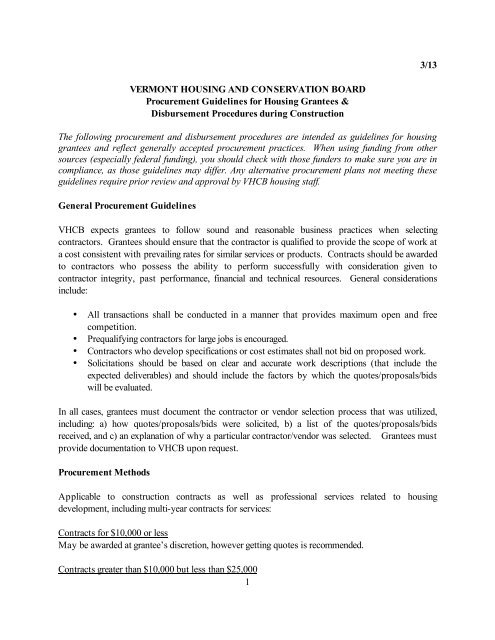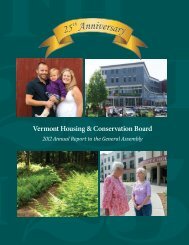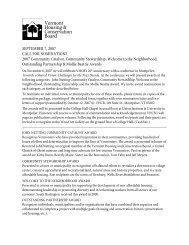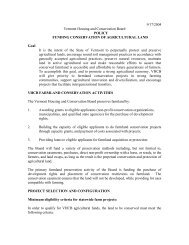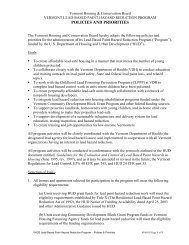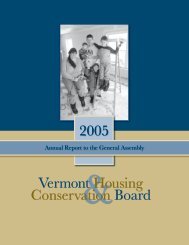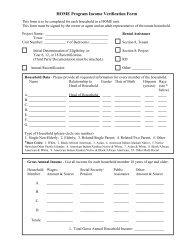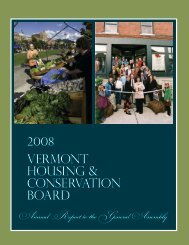Attachment A: VHCB Procurement Guidelines and Construction ...
Attachment A: VHCB Procurement Guidelines and Construction ...
Attachment A: VHCB Procurement Guidelines and Construction ...
- No tags were found...
You also want an ePaper? Increase the reach of your titles
YUMPU automatically turns print PDFs into web optimized ePapers that Google loves.
3/13VERMONT HOUSING AND CONSERVATION BOARD<strong>Procurement</strong> <strong>Guidelines</strong> for Housing Grantees &Disbursement Procedures during <strong>Construction</strong>The following procurement <strong>and</strong> disbursement procedures are intended as guidelines for housinggrantees <strong>and</strong> reflect generally accepted procurement practices. When using funding from othersources (especially federal funding), you should check with those funders to make sure you are incompliance, as those guidelines may differ. Any alternative procurement plans not meeting theseguidelines require prior review <strong>and</strong> approval by <strong>VHCB</strong> housing staff.General <strong>Procurement</strong> <strong>Guidelines</strong><strong>VHCB</strong> expects grantees to follow sound <strong>and</strong> reasonable business practices when selectingcontractors. Grantees should ensure that the contractor is qualified to provide the scope of work ata cost consistent with prevailing rates for similar services or products. Contracts should be awardedto contractors who possess the ability to perform successfully with consideration given tocontractor integrity, past performance, financial <strong>and</strong> technical resources. General considerationsinclude:• All transactions shall be conducted in a manner that provides maximum open <strong>and</strong> freecompetition.• Prequalifying contractors for large jobs is encouraged.• Contractors who develop specifications or cost estimates shall not bid on proposed work.• Solicitations should be based on clear <strong>and</strong> accurate work descriptions (that include theexpected deliverables) <strong>and</strong> should include the factors by which the quotes/proposals/bidswill be evaluated.In all cases, grantees must document the contractor or vendor selection process that was utilized,including: a) how quotes/proposals/bids were solicited, b) a list of the quotes/proposals/bidsreceived, <strong>and</strong> c) an explanation of why a particular contractor/vendor was selected. Grantees mustprovide documentation to <strong>VHCB</strong> upon request.<strong>Procurement</strong> MethodsApplicable to construction contracts as well as professional services related to housingdevelopment, including multi-year contracts for services:Contracts for $10,000 or lessMay be awarded at grantee’s discretion, however getting quotes is recommended.Contracts greater than $10,000 but less than $25,0001
Oral or written quotes from at least three qualified sources is recommended but not required. If lessthan three quotes are solicited or received, a written explanation of the selection process must be onfile, <strong>and</strong> the quality <strong>and</strong> cost reasonableness of the selected contractor/vendor must be demonstrated.Contracts between $25,000 <strong>and</strong> $100,000Formal publically advertised bids are encouraged, but written quotes from an adequate number ofqualified sources (see above) are acceptable. If publically advertised, the selection must be based onthe criteria spelled out in the request for proposals. In general, awards should be made to theproposal from a qualified bidder that is most advantageous to the project, with consideration ofprice as well as other factors, as specified in the request for proposals/bids.Contracts over $100,000Bids must be solicited through formal, public advertising. Prequalifying contractors is encouraged<strong>and</strong> sealed bids are recommended. When sealed bids are used, the contract shall be awarded to theresponsive qualified bidder whose conforming bid was the lowest.Sole SourceThere may be some instances where procurement from a sole source is appropriate (for example,highly specialized trades for which there are a limited number of professionals in the area), howeverthe justification must be very carefully documented. Contracts $25,000 or greater require preapprovalfrom <strong>VHCB</strong> staff.RFP/RFB languagePublic advertisements must include language that encourages minority <strong>and</strong> women-owned businessesas well as small, locally owned businesses to apply. For contracts being paid in part or full withHOME or other federal funds through <strong>VHCB</strong>, advertisements should also include languageencouraging Section 3 businesses to apply. (There are additional federal contractordebarment/eligibility <strong>and</strong> Section 3 requirements for the use of HOME funds. See <strong>VHCB</strong>’s HOMEH<strong>and</strong>book - Chapter 8: <strong>Procurement</strong> <strong>and</strong> <strong>VHCB</strong>’s Section 3 Policy for more details).Bonding <strong>and</strong> InsuranceFor all contracts greater than $100,000, a 5% bid bond <strong>and</strong> 100% payment <strong>and</strong> performance bondsare required. Alternatively, a 25% irrevocable letter of credit may be substituted for any of the aboverequired bonds.Grantees are responsible for determining the level <strong>and</strong> type of insurance that they wish to haveprovided by the contractor. Suggested minimum levels include:• Comprehensive All Risk Motor Vehicle Liability Insurance, with minimum combined limitof $1,000,000.2
• Comprehensive General Liability (CGL) insurance (bodily injury <strong>and</strong> property damage)with a minimum per occurrence, general aggregate, <strong>and</strong> products/completed operationsaggregate of $1,000,000.• Any other insurance required by law, including but not limited to workers’ compensation.A unified owner’s insurance package (where the owners, any limited liability corporations, thecontractor, <strong>and</strong> potentially the architect all buy insurance from the same firm for a specified project)is strongly preferred.The policy shall name <strong>VHCB</strong> <strong>and</strong> its officers <strong>and</strong> employees as additional insureds for liabilityarising out of the contract. Documentation of insurance may be requested by <strong>VHCB</strong>.<strong>Construction</strong>There are two acceptable types of construction contracting: using a general contractor (GC) or usinga construction manager (CM).Under the GC model, the grantee only works directly with the GC with whom they have one singlecontract. The GC hires subcontractors, but the grantee does not have any involvement in thatprocess.Under a CM model, the grantee has a direct contractual relationship with all of the individualsubcontractors, as well as the construction manager. The CM may perform some of theconstruction work, but their primary job is to bid out the subcontracts <strong>and</strong> manage the constructionprocess with input from the grantee.When a construction manager is used, <strong>and</strong> the sum of all subcontracts for construction work exceeds$100,000, the project <strong>and</strong> the individual subcontracts must be publicly advertised. Documentationmay be requested by <strong>VHCB</strong>.<strong>VHCB</strong> may permit grantees to be their own construction manager in certain circumstances, providedthat they have a qualified construction professional on staff manage the work (e.g.: rehab specialist,clerk of works, or architect). Pre-approval from <strong>VHCB</strong> staff is required.Retainage<strong>VHCB</strong> requires that grantees retain 10% of the contract amount until the project is substantiallycomplete, however for large projects (over $3,500,000) retainage may be reduced to 5% at 50%completion (i.e. no additional retainage is held from the time of 50% completion until 100%completion).Escrowing work remaining <strong>and</strong> punchlist items3
For construction work remaining due to seasonal or weather related restrictions, <strong>VHCB</strong> recommendsholding in escrow at least 100% of the value of that work, as certified by the architect/engineer. Forpunchlist items, <strong>VHCB</strong> recommends holding a punchlist escrow of at least 200% of the value of thatwork.Final title opinion:Please be advised that a st<strong>and</strong>ard condition of <strong>VHCB</strong> grant agreements requires a final title opinionupon project completion.Disbursement Procedures for <strong>Construction</strong>Prior to first construction disbursement, Grantee must provide an executed construction contract(s)<strong>and</strong> a copy of the performance <strong>and</strong> payment bond or letter of credit if applicable. Upon request, abid summary may be required as well. Copies of other construction related documents are requiredfor HOME grantees (see <strong>VHCB</strong>’s HOME H<strong>and</strong>book - Chapter 8: <strong>Procurement</strong> for more details).Except under certain circumstances, disbursements shall not be made more frequently than once amonth. Grantees should submit requests to housing staff <strong>and</strong> expect two weeks to receive a check.For each disbursement request, the grantee must submit a copy of the AIA form G702 Application<strong>and</strong> Certificate for Payment (or an alternative form acceptable to <strong>VHCB</strong>) signed <strong>and</strong> notarized bythe contractor, <strong>and</strong> certified by the third party architect or project manager. A continuation sheet(G703) should be attached which corresponds to the schedule of values set forth in the constructioncontract. Please be sure to include any change orders. Disbursements of HOME funds are subjectto <strong>VHCB</strong>’s HOME <strong>Construction</strong> Progress Inspection Policy (see HOME H<strong>and</strong>book).For those jobs where there is a general contractor, disbursement requests must include a lien waiverprovided by the general contractor for payment received to-date or an updated title opinion.For construction jobs with a construction manager, disbursement requests for multiple contractsmust be submitted on one AIA contract form that incorporates all the construction subcontractswith a combined schedule of values. This will be the basis for all disbursements, retainage, <strong>and</strong>certifications. The AIA form must be signed by the construction manager <strong>and</strong> notarized, <strong>and</strong>certified by a qualified third party.In the above case, disbursement requests must include lien waivers provided by each contractor forpayment received to-date regardless of contract amount or an updated title opinion.4
Disbursements of federal funds for constructionIn general, disbursements of federal funds for construction costs will only be made for completedwork in place <strong>and</strong> will be based on the percentage of completion of the total amount of workcovered by the contract, less 10% retainage. (For example: assume that the total contract amount is$2,000 <strong>and</strong> the HOME award is $1,000. If the total amount of work covered by the contract is 50%completed on the date of a particular requisition, the maximum amount of HOME funds that can bedisbursed at that time will be $500 less 10% retainage, or $450.)5


